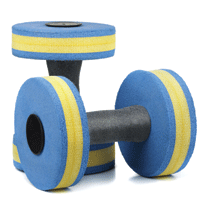The pool is an excellent place to exercise. Your body is buoyant in water, putting much less weight on your joints, and making getting in shape safer and less painful. But rest assured: It’s still a real workout. As you move through the water, you’ll encounter much more resistance than you would on land. That effort builds muscle, which helps to protect your joints from bleeds.
“Water exercise also builds endurance, so that you can sustain activities for longer periods and get some real cardiovascular benefits,” says Grace Volsen, MPT, a physical therapist at Confluence Health at Central Washington Hospital in Wenatchee.
Water therapy helped Larry Hammerness, 50, get back on his feet after surgery on both ankles. “I walked in the water to regain the muscles that had atrophied while I was in ankle casts for six weeks,” he says. Hammerness is a Los Angeles-based photographer with severe hemophilia A. After physical therapy ended, he continued using the pool, doing stretches in the water and exercises such as weighted leg lifts.
Cindy Bailey, PT, DPT, OCS, SCS, director of the physical therapy program at the Hemophilia Treatment Center at Orthopaedic Hospital of Los Angeles, stresses safety first for nonswimmers and pool veterans alike. “No one, not even an Olympic swimmer, should ever enter the water without a lifeguard in the area to watch, assist and be there for safety,” she says.
Diving in, slowly
Water workouts are ideal for just about everyone, from people just getting off the couch to competitive athletes. If you’re new to aquatic exercise, start slowly, says Volsen. At first, stick with water walking in the shallow end. Then, as you build strength and balance, move to deeper water, where you’ll meet more muscle-challenging resistance. “Walking’s the perfect first step,” says Volsen.
It will take time to adapt to your new exercise. Ask your PT what to expect. A couple of weeks of muscle soreness, for example, is normal. Push on and you’ll be rewarded. “After a month or so, you’ll notice your muscles getting stronger,” Bailey says.

Coprid/Thinkstock
After you get the hang of walking in the pool, add specialized equipment to your workout for a greater challenge. For example, Volsen likes to introduce foam ankle cuffs to her more advanced water walkers. “While wearing them, they really have to work their legs and their core to stay stable in the water,” she says. (Read the sidebar,“Aquatic Exercise Equipment,” in HemAware’s free iPad app.)
Stationary running is another beneficial exercise, even if you have ankle, knee or hip problems. Strap on a flotation belt or life vest, and you can run in deep water without touching the bottom of the pool. “It will make you really, really tired,” says Bailey. Fatigue is a sign that you’re giving your body a solid workout. But before your first dip in the pool, talk to your doctor about any necessary precautions.
Other classes offered at your local YMCA, community center or commercial gym may include:
- Ai Chi. A pool-based spin-off of tai chi, ai chi uses slow, controlled movements to build strength, balance and stability.
- Shallow Water Aerobics. Performed in water that comes up no higher than your shoulders, shallow water aerobics will boost your strength and flexibility as your heart beats at a faster rate.
- Deep Water Aerobics. These no-impact cardio exercises work your core muscles, increasing strength and balance, and improving heart health.
Group classes are an ideal way to get in shape, says Bailey. She recommends finding instructors who have experience working with people with joint issues. For example, the YMCA developed a water therapy program in collaboration with the Arthritis Foundation, she says.
Taking part in classes makes aquatic exercise much more fun and rewarding. “You bond with your classmates, you make friendships, you stay accountable and you keep going,” Volsen says.

